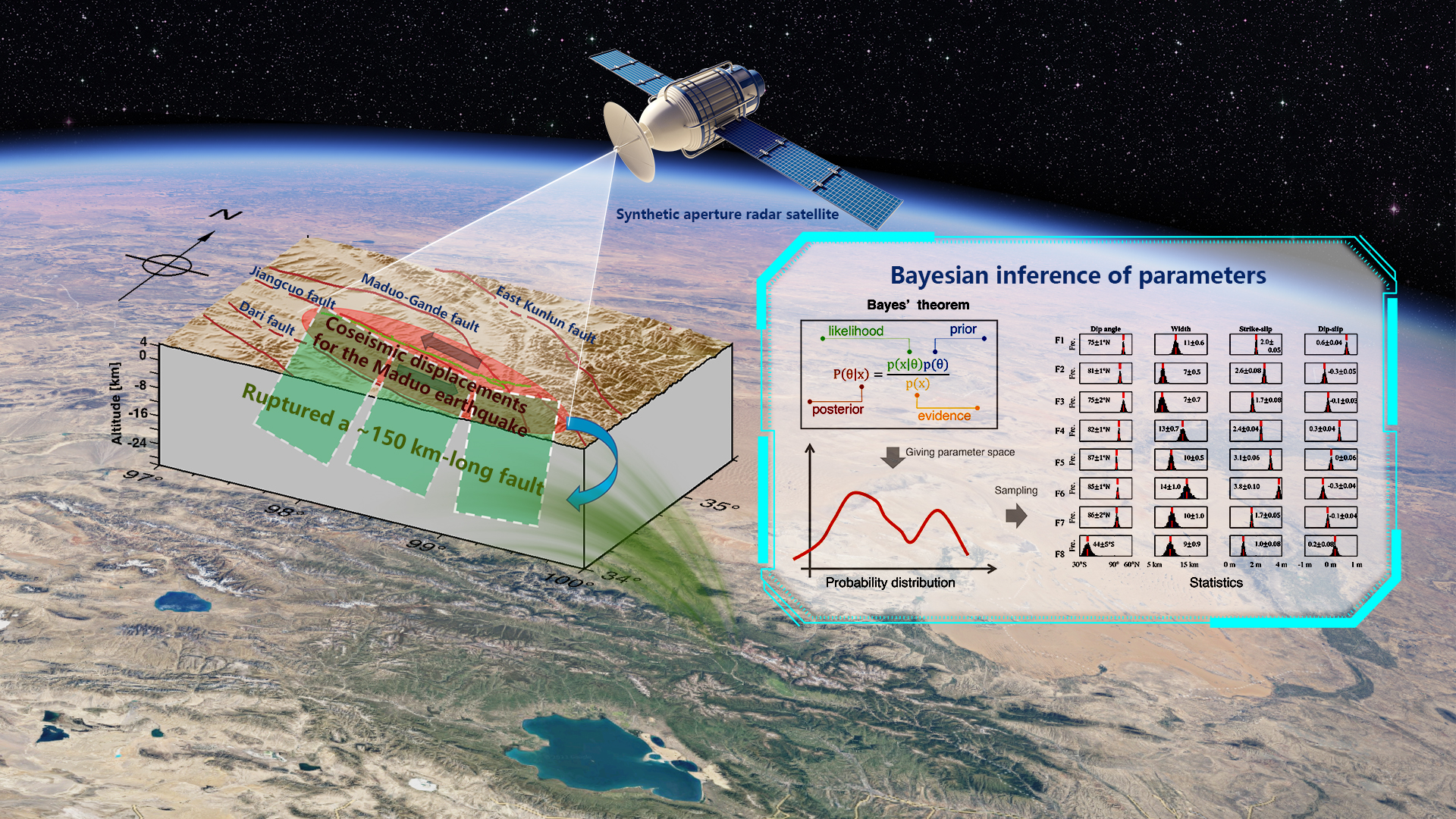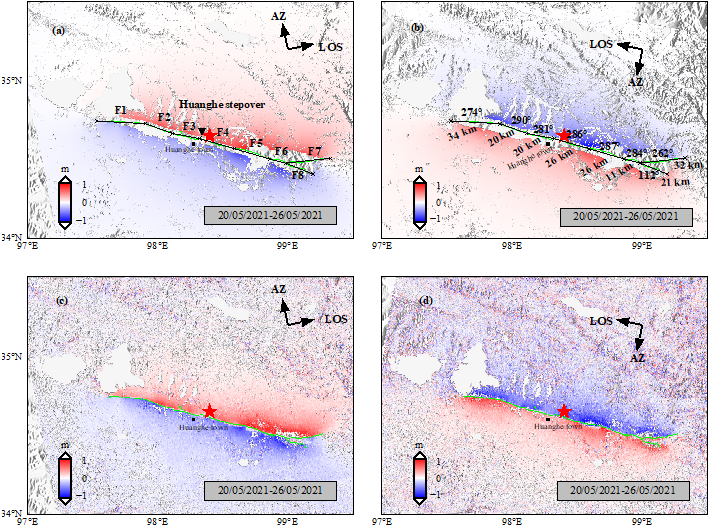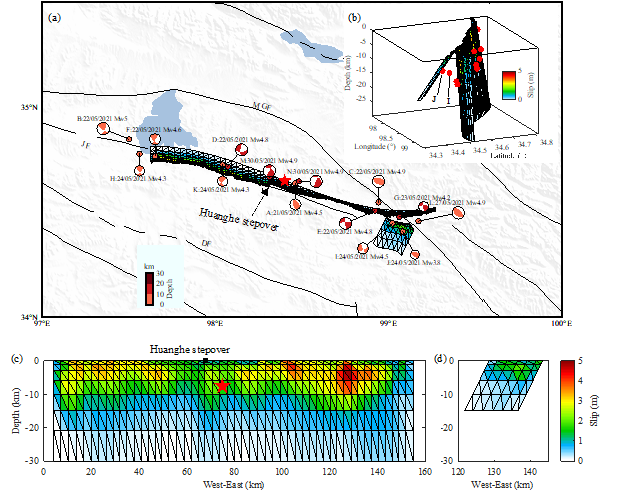As widely recognized, fault geometry plays a crucial role in geological processes, including earthquakes, crustal movements, and rock deformation. Accurately describing the geometry of faults is a critical challenge in the fields of geology and seismology, essential for earthquake prediction and mitigation.

In a recent study led by Associate Professor Kejie Chen’s team from the Department of Earth and Space Sciences (ESS) at the Southern University of Science and Technology (SUSTech), they developed and employed a Bayesian inversion framework, which integrated geodetic measurements and geological survey data. The Bayesian inversion findings, coupled with an examination of aftershock mechanisms, revealed that although the earthquake predominantly featured strike-slip rupture, the southeast branch fault exhibited a low angle. This observation suggests that low-angle faults may also nurture strike-slip ruptures, shedding significant light on our understanding of fault dynamics and large-scale strike-slip rupture mechanisms.
Their research work, entitled “Complex strike-slip faulting during the 2021 Mw7.4 Maduo earthquake”, has been published in the journal Communications Earth & Environment (CEE).
Chen’s team developed a Bayesian nonlinear inversion framework that leveraged multiple sources of geodetic data. This framework enabled the simultaneous estimation of non-planar fault geometry parameters, fault slip distributions with spatially variable rake, and the weighting of multiple observation data. In this Bayesian inversion framework, the posterior probability density distributions of all model parameters were estimated using the Markov Chain Monte Carlo method.
This algorithm work, entitled “Bayesian Inversion of Finite-Fault Earthquake Slip Model Using Geodetic Data, Solving for Non-Planar Fault Geometry, Variable Slip, and Data Weighting”, was published in the Journal of Geophysical Research: Solid Earth (JGR: Solid Earth) in January of this year, and was also featured as the Editors’ Highlights in the “Earth and Space Science News” by the American Geophysical Union (AGU).
On May 21, 2021, an M7.4 earthquake struck Maduo County, Qinghai Province. This event marked the most significant earthquake in China since the 2008 M8.0 Wenchuan earthquake, drawing substantial attention from both the domestic and international scientific community. The earthquake involved a blind fault, and the spatial distribution of aftershocks did not align with the surface rupture traces. Currently, there is ongoing debate regarding fault geometry, particularly in the southeastern branch.

Figure 1. Co-seismic deformation of the 2021 Maduo earthquake. Co-seismic deformation field was measured using Sentinel-1 Synthetic Aperture Radar satellite ascending and descending track interferometry (a, b) and pixel offset method (c, d).
Based on observations of surface rupture traces through remote sensing and geological surveys, Chen’s team analyzed the seismic fault geometry of the Maduo earthquake by dividing it into eight segments (Figure 1). Specifically, using Sentinel-1 measurements, Global Navigation Satellite System (GNSS) static displacements, and their own Bayesian nonlinear inversion framework to estimate the probability distributions of key parameters for each fault segment, including dip, width (in the down-dip direction), and slip. Subsequently, based on the statistical analysis of these parameter probability distributions, they determined the geometry and slip characteristics of the eight fault segments, which were then used to produce a three-dimensional fault geometry (Figure 2a).

Figure 2. (a) Fault slip distribution model and tectonic setting. Source mechanisms of aftershock events A-N color-coded by depth. (b) 3-D view of the slip distribution model and aftershock locations. (c,d) The front view (from south to north) of the fault slip distribution.
Anderson’s fault theory predicts that strike-slip faults should exhibit near-vertical orientations under the influence of tectonic stress conditions. Most observations show that strike-slip faults have high dipping angles, confirming Anderson’s predictions. However, the findings from this study present a departure from this norm, highlighting the southeastern branch fault (Segment F8) as an exception with a relatively low dipping angle (44±5°), with the strike-slip component (1.0 meters) significantly larger than the dip-slip component (0.2 meters). Furthermore, the study used broadband waveform inversion within 300 kilometers of the epicenter to ascertain the source mechanism of the largest aftershock, designated as “J”, situated on the southwestern side of this branch fault.
The results showed that the depth of aftershock J is 5.5 kilometers, with a vertical distance of only 0.1 kilometers from the surface of the southeastern branch fault (Figure 2b). Aftershock J manifests a nodal plane with a strike of 129° and a dip of 53°, which is similar to the fault geometry of the southeastern branch fault with a strike of 112° and a dip angle of 44±5°. This alignment further suggests the existence of shallow-dipping seismogenic faults, hinting at a potential alteration in the principal stress direction within the southeastern part of the fault. Such an alteration could prompt the transformation of the strike-slip fault into a thrust fault.
The complexity of fault geometry affects fault rupture characteristics, resulting in heterogeneous and segmented slip distributions along the rupture fault. To the west of the epicenter, the fault dips slightly northward. Consequently, fault slip mainly occurs at shallower depths, with the maximum slip occurring near the surface (Figure 2c). In contrast, the fault to the east of the epicenter is nearly vertical, with deeper and broader fault slip, and the maximum slip occurs at depths of 3-6 kilometers. Finally, the slip distribution on the southeastern branch fault is relatively small, with the maximum slip occurring at depths of 2-6 kilometers (Figure 2d).
Guoguang Wei, a Ph.D. student in Professor Kejie Chen’s team, is the first author of this paper. Mingzhe Lyu, a graduated master’s student who is now a Ph.D. student at Nanyang Technological University, is the third author, and Professor Kejie Chen is the corresponding author. Collaborators included Professor Lingling Ye, Ph.D. student Wenzheng Gong from the Department of ESS at SUSTech, Luca Dal Zilio from ETH Zurich, and R Hongwei Tu from the Qinghai Earthquake Agency.
This study was supported by the National Natural Science Foundation of China (NSFC) and the European Union research projects “A Digital Twin for Geophysical Extremes” and “Fault Activation and Earthquake Rupture” (FEAR).
Paper links:
Communications Earth & Environment: https://www.nature.com/articles/s43247-023-00980-6
Journal of Geophysical Research: Solid Earth: https://agupubs.onlinelibrary.wiley.com/doi/abs/10.1029/2022JB025225
To read all stories about SUSTech science, subscribe to the monthly SUSTech Newsletter.
Proofread ByKejie CHEN, Yingying XIA, Adrian Cremin
Photo By